Table of Contents
Critically endangered in the wild, abundant in farms for skin trade.
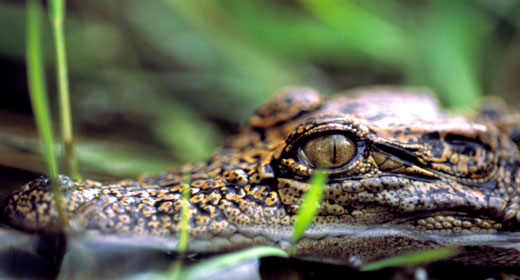 |
| A young Siamese Crocodile. Credits: Fauna and Floral International |
1.0 Quick Facts:
1.1 Etymology (Why is the name as such?)
‘Siam’ was the old name for Thailand. Siamese Crocodile was originally abundant in freshwater swamps and slow flowing waters of Thailand and thus was named as such. (Kanwatanakid-Savani et al., 2012)1.2 Current status
Due to overexploitation for skin and meat, the species is now CRITICALLY ENDANGERED (Bezuijen, et al., 2012) and has a CITES listing of Appendix I, the highest level of listing. (More details below)1.21 How is Singapore part of the equation?
C.siamensis is not native to Singapore. However, Singapore still plays an important role in their low numbers due to breeding in crocodile farms in the past, and right now, the import of skins to be processed in the tannery as well as the export of processed skin. (More details below)2.0 Description
2.1 Diagnosis
Most people often confuse between alligators, caiman and gharials with crocodiles. This is how one should distinguish them (Richardson et al., 2000; Webb and Manolis, 1989).2.11 Alligators and caimans
 |
| Side and Top view of an alligator's snout. Credits: Crocodile Specialist Group |
Alligators are often described as "shovel-shaped" as they have broad snouts. When the jaws are closed, many of the teeth of the lower jaw fit into sockets along the edge of the expanded upper jaw. In the alligators and caimans, the 4th tooth from the back fits into a socket in the upper jaw when the jaws are closed, such that its tip is hidden.
2.12 "True" crocodiles
 |
| Side and Top view of a crocodile's snout. Credits: Crocodile Specialist Group |
The upper jaw of "true" crocodiles is constricted and not as broad as that of alligators and caimans. The enlarged 4th tooth on the lower jaw will rests in the notch when the jaw is closed, and its tip is clearly visible. This is a major distinction between "true" crocodiles and alligators and caimans.
2.13 Gharials
 |
| Side and Top view of a gharial's snout. Credits: Crocodile Specialist Group |
The Gharial has a greatly elongated snout by compacting the cranial part of the skull at the rear. Gharials have a greater proportion of the head allocated to the snout. Thus, the head length of a Gharial is similar to the head length of a Saltwater Crocodile of the same total length.
2.14 Distinguishing feature of the Siamese Crocodile
Most Siamese Crocodile has a twin paired, raised post occipitals. However, as hybridisation is a common occurrence these days, DNA test is still the best way to identify a Siamese Crocodile.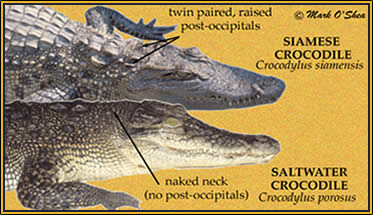 |
| Credits: Mark O' Shea TV series |
2.2 Adult
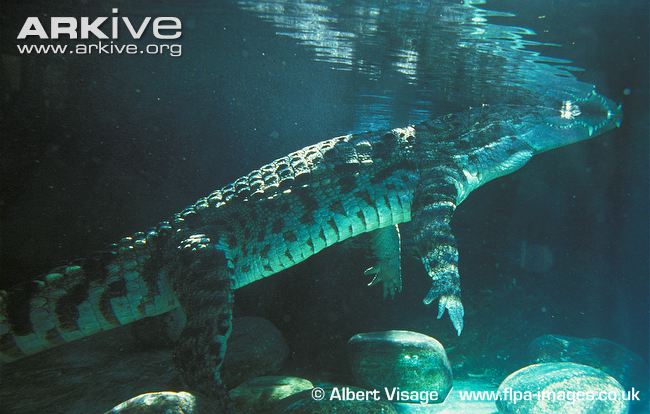 |
| An adult swimming underwater. Credits: Albert Visage from www.flpa-images.co.uk. Taken from Arkive.org |
Maximum size reported for the species is between 3,000 and 3,300 mm in total length with the average total length being 2,500-3,000 mm, and 240-290 mm in hatchlings. The snout ratio is 1.5 – 2.0 with 1 ridge on skull. The neck region has 4 post-occipital scales and 6 nuchal scales. Dorsal osteoderms are 16 –17 rows. Ventral scales are arranged in 30 to 34 transverse rows and 14 to 16 longitudinal rows. Tail and belly inclusions are visible as well as ISO. The colour of adults is olive-brown on the dorsal area, with large black markings on the tail. The ventral area is pale with a creamy-yellowish tone (CITES, 2013).
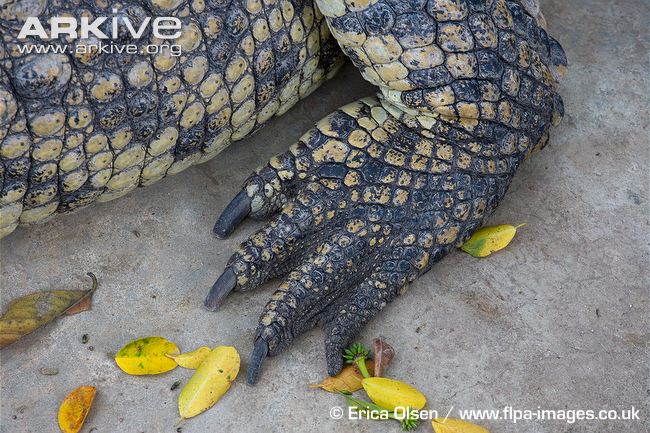 |
| A close up on a Siamese crocodile's foot. Credits: Erica Olsen / www.flpa-images.com.uk. Taken from Arkive.org |
2.3 Young
The young are usually golden in colour with black stripes on the body and tail (Crocodile Specialist Group, 2013d).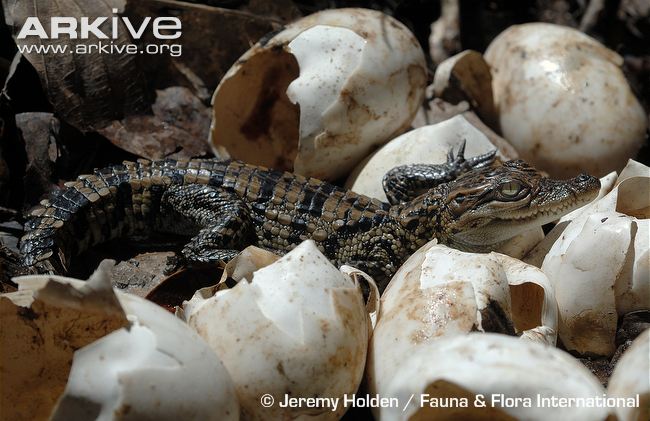 |
| A Siamese crocodile hatchling. Credits: Jeremy Holden / Fauna & Floral International. Taken from Arkive.org |
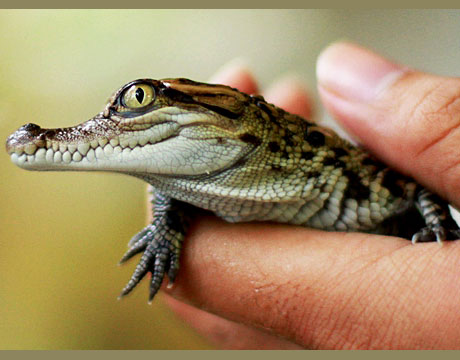 |
| A young from the Laos zoo. Credits: M. Douangmyxay / WCS Laos Program |
3.0 Biology
3.1 Feeding habits
Adult C. siamensis feed mainly on fish. However, as with other crocodiles, they feed on all types of prey including invertebrates, reptiles, amphibians, birds, mammals and even carrion (Daltry, et al., 2003).3.2 Reproduction
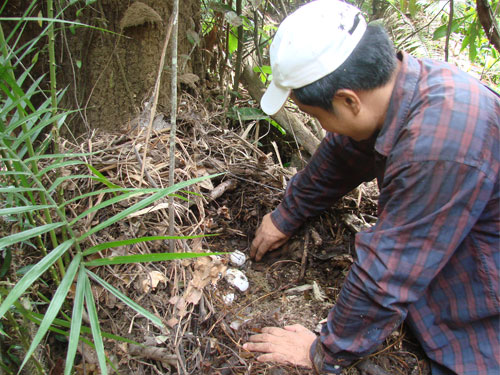 |
| A crocodile warden unearth a Siamese Crocodile's nest in Cambodia. The eggs were one foot deep in the chamber. Credits: Fauna & Floral International |
leaves and woody debris on vegetation mats or river banks (Simpson, Chheang & Han, 2006). The
incubation period is around 75 days (Simpson, Chheang & Han, 2006).It is believed that the females would visit the nests frequently after laying the eggs and help the hatchlings as they emerge during the wet season (June- August), transporting them into the water with their mouth (Alderton, 1991).In contrast to almost all other crocodilian species, the typical post-hatching parental care is implemented by males and females (Crocodile Specialist Group, 2013d). Dry season (April-May) is also the nesting period, where eggs are laid on mounds built by females with soil,
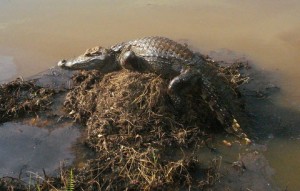 |
| A female guarding her nest in Mesangat Lake, East Kalimantan. The place one of the six pre-selected projects of the EAZA IUCN SSC Southeast Asia Campaign, Siamese Crocodile being one of the target species for conservation. Credits: Agata Staniewicz from the EAZA IUCN SSC Southeast Asia Campaign. |
4.0 Distribution
Native: Cambodia, Indonesia, Lao People's Democratic Republic, Thailand and Vietnam (Simpson & Bezuijen, 2010)- Possible to also be found in Malaysia and Myanmar but no surveys have been carried out (Simpson & Bezuijen, 2010).
- Extant populations are rare, most stable in Cambodia (Simpson & Bezuijen, 2010) and Indonesia (Species Survival Commission of IUCN, 2013). Even so, the numbers are still relatively unknown.
- Laos have populations across four provinces but actual number unknown (Simpson & Bezuijen, 2010).
With all these limited data, it is estimated that the global wild population of C. siamensis is fewer than 1,000 mature individuals (Bezuijen, et al., 2012).
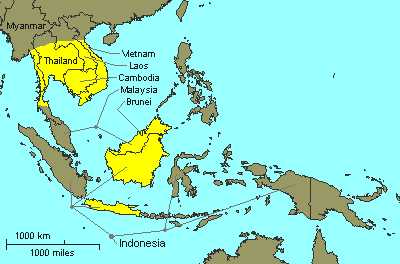 |
| (Ferioli, n.d.) Obtained from http://crocodilian.com/cnhc/cst_csia_dh_map.htm |
4.1 Singapore
In Singapore, the Singapore Crocodilarium Pte. Ltd. was the only crocodile farm that bred C. siamensis. In 2000, the registration for the crocodile farm to breed C. siamensis for commercial purposes was granted (Geneva Convention, 2000). Despite it closing down, there is still an active trade of skin from C. siamensis going on (Caldwell, 2011).The skin is processed at the Heng Long Tannery which founded the Singapore Reptile Skin Trade Association (Heng Long Leather Co. Pte Ltd, 2013).5.0 Current status
Assuming one generation is 25 years, the global population has declined by over 80% in the past three generations i.e. 75 years (Bezuijen, et al, 2012). Populations may still be surviving but they have been severely fragmented. With such a basis and with earlier mentioned of collected data, the C. siamensis fitted into the IUCN‟s criteria of CRITICALLY ENDANGERED (Bezuijen, et al., 2012) and has a CITES listing of Appendix I, the highest level of listing.6.0 Threats
6.1 Skin Trade
The biggest threat to Siamese crocodiles, as with every other 22 species of crocodiles in the world, is skin trade. Singapore is one of the countries producing crocodile leather of best quality in processing plants known as tannery (Crocodile Specialist Group, 2013b). The demand for crocodile skin in the luxury industry has fuelled the growth of crocodile farms, with an international sales worth over $200 million (Conservation International, 2013). With an annual figure of more than 34 000 skins in 2009, C. siamensis is one of the main species being traded internationally in terms of volume (Caldwell, 2011). The primary cause of decline of C. siamensis before 2000 was the overexploitation of wild populations to supply crocodile farms, resulting in the wild population to decline to an unsustainable size (Bezuijen, et al., 2012). With the increase in number of crocodile farms over the years, illegal poaching of wild C. siamensis to supply to the farms is still ongoing (Bezuijen, et al., 2012). Thailand had just requested in 2012 for the downlisting of C. siamensis from Appendix I to Appendix II, a move that was supported by a few countries, including Singapore and Cambodia (Jantrarotai, 2013) even when they do not even have healthy populations of wild C. siamensis in the first place.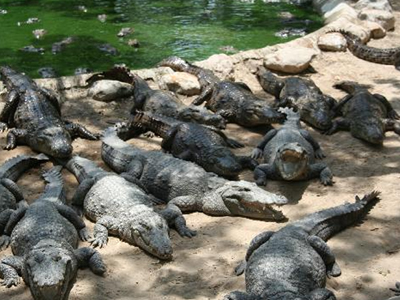 |
| An example of a crocodile farm in China. Credits: WeSpeakNews Green |
6.2 Exotic Meat
Other than being hunted for their skin, C. siamensis is also killed for their meat. The export of live juveniles from 1998 to 2008 from Cambodia, Vietnam and Thailand to China, where this exotic meat is considered a delicacy and traditional Chinese medicine, amounted to 466 000 individuals (Crocodile Specialist Group, 2013b).6.3 Habitat Loss
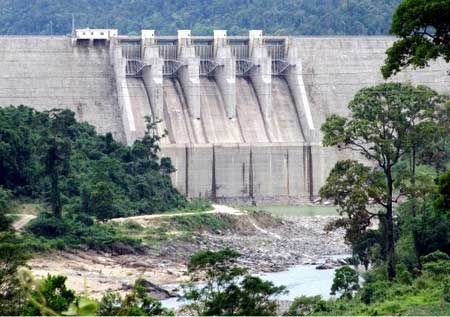 |
| The Vinh Son hydropower reservoir in Vietnam that resulted in inhabitable environment for the Siamese Crocodiles to live in. Credits: VietNamNet online newspaper. |
Habitat loss is another major threat that C. siamensis faces. As extremely territorial animals, crocodiles require large living spaces and many of this freshwater crocodiles inhabit rivers that have been or are planned to be dammed for hydropower (Bezuijen, et al., 2012). Damming of rivers converts them into reservoirs, making the environment unsuitable for crocodiles to nest and reproduce as reservoirs flood at unnatural frequencies and higher levels. 5 hydropower dams have been proposed to be built in Cambodia’s Cardamom Mountains where possibly up to 60% of global population of C. siamensis reside in (Fauna & Flora International, 2013).
6.4 Lack of genetic diversity
With small and fragmented populations, the C. siamensis is inherently threatened with the risk of being wiped out by diseases, inability to reproduce enough to sustain their population and the lack of genetic diversity. The problem is escalated by the by the hybridisation of this species with C. porosus or C. rhombifer in crocodile farms to give crocodiles that grow faster and provide better quality leather (Conservation International, 2013). The accidental mixture of escaped hybrids with wild populations will further dilute the gene pool of wild C. siamensis. Hybridisation will also reduce the possibilities of reintroducing captive bred crocodiles back into the wild lest gene mixing occurs.6.5 Global Warming
In addition to direct threats to their survival, C. siamensis is also endangered by global warming (Bezuijen, et al., 2012). As the genders of crocodiles are determined by the temperature of the egg environment during incubation, rising temperatures cause more female crocodiles to hatch, tipping the balance of gender ratio and impeding reproductive efforts (Douglas, 2006).7.0 Conservation efforts
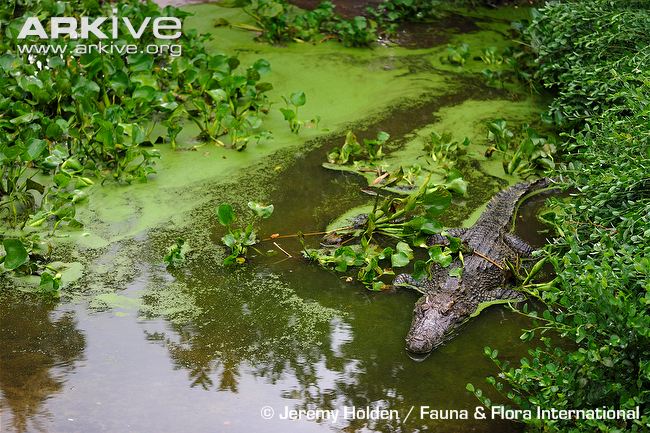 |
| A female at a Phnom Tamao wildlife rescue centre. Credits: Jeremy Holden / Fauna & Flora International. Taken from Arkive.org |
 |
| Community crocodile wardens uncovered 18 hatchlings in a wild nest in Cambodia in 2012. A boost to the conservation efforts of the FFI. Credits: Fauna and Floral International |
Currently, there are a few organisations working on the conservation of the Siamese Crocodile. Apart from Fauna & Flora International which focuses on C. siamensis populations in Cambodia, most conservation works in other countries are advised and monitored by the Crocodile Specialist Group.
The IUCN-SSC Crocodile Specialist Group (CSG) is a worldwide network of biologists, wildlife managers, government officials, independent researchers, non-government (NGO) representatives, farmers, traders, tanners, fashion leaders, and private companies actively involved in the conservation of the world's 23 living species of alligators, crocodiles, caimans and gharials in the wild (Crocodile Specialist Group, 2013a).
The CSG network of experts advises governments and wildlife management agencies, evaluates the conservation needs of crocodilian populations, initiates research projects, conducts surveys of wild populations, provides technical information and training, initiates conservation programs, etc (Crocodile Specialist Group, 2013a). In the face of increasing Human-Crocodile Conflict (HCC), the CSG also established a Human-Crocodile Conflict Working Group in 2002 (Crocodile Specialist Group, 2013c).
8.0 Taxonomy (Encolypedia of Life) & Possible Phylogentic Tree
Binomial: Crocodylus siamensis by Schneider, 1801Vernacular: Siamese Crocodile
1 synonym: Crocodilus galeatus by Cuvier 1807
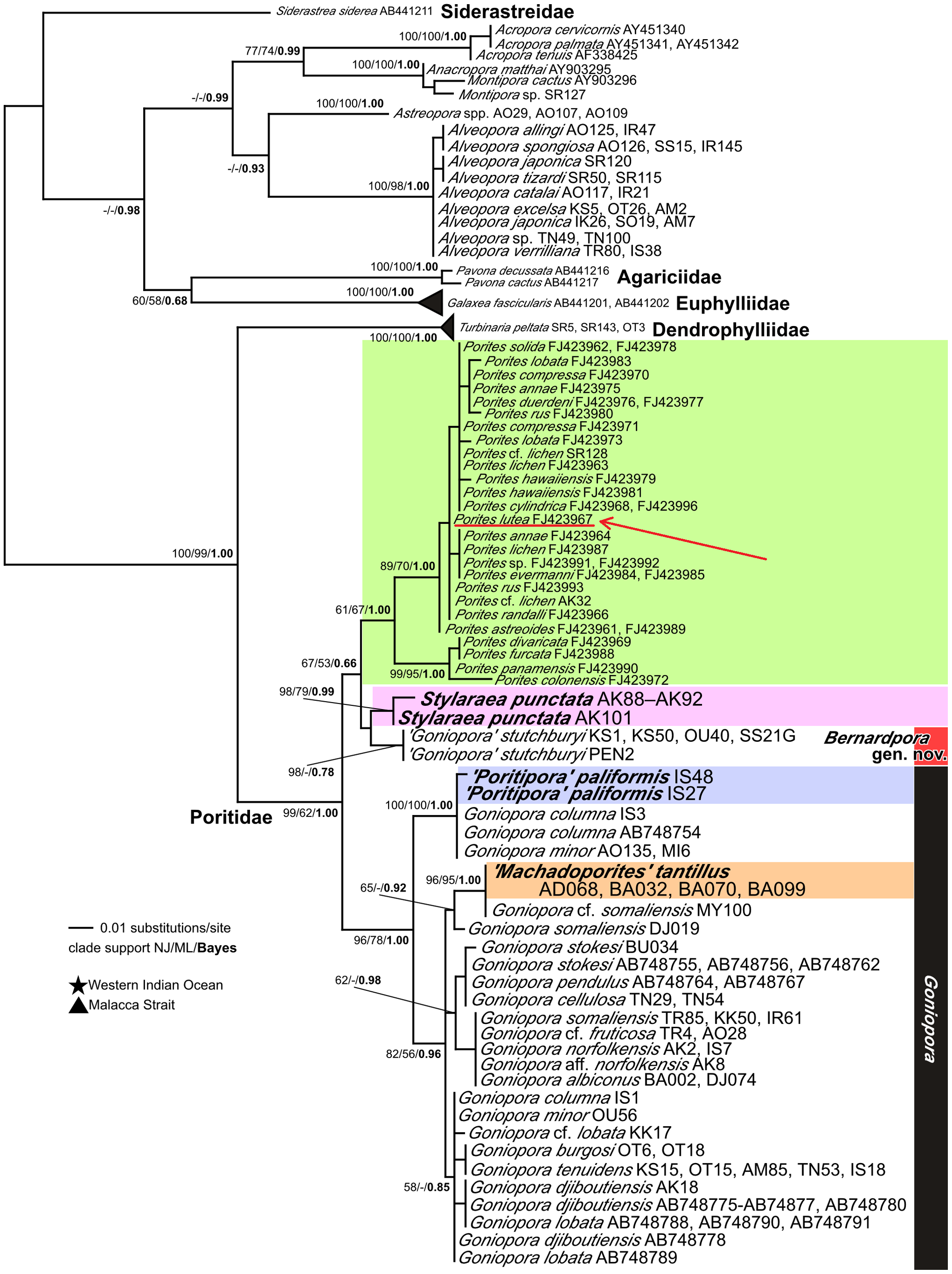
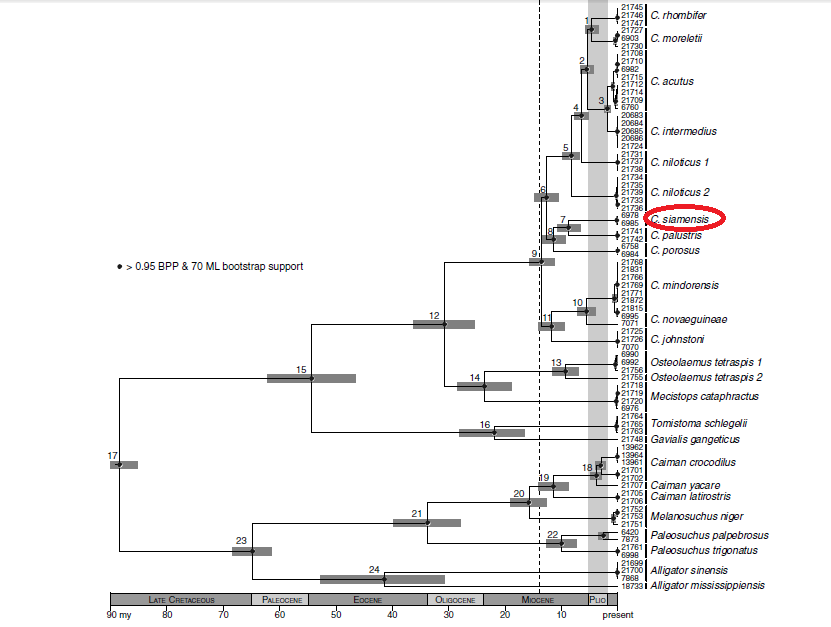 |
| The majority-rule consensus tree with mean node ages from the BEAST posterior sample. Bars at nodes represent the 95% highest posterior density (i.e. probablility) of the node age. The Tertiary, after the mid-Miocene climatic optimum (dashed line), was marked by extinctions of crocodilians, which culminated in the Pliocene (gray bar) (Markwick 1998). Taken from Oaks (2011). (Direct permission not obtained, but within the limits of Fair Use) |
In 2012, Srikulnath et al. discovered a new genome (haplotype2, EF581859) as effective markers to successfully differentiate C. siamensis from C. porosus and hybrids between both species. The results were consistent with the phylogenetic relationship among the three genomes C. porosus (AJ810453), haplotype1 (DQ353946), and haplotype2 (EF581859). Rapid and accurate species identification in population, ecology and, conservation studies especially for the re-introduction programs can thus be done.
9.0 Type Information
At the Museum Zoologicum Bogoriense, Indonesia, is the oldest collection of C. siamensis recorded from Cilebar,Bogor, on 24 April 1927 (Prihadi, 2011). |
| An old skull piece of a Siamese Crocodile at the Museum Zoologicum Bogoriense, Indonesia (Prihadi, 2011) |
10.0 What can YOU do?
Help stop the demand by not buying crocodile skin products or their meat products! Spread the awareness around and support the conservation cause. (:11.0 Literature and References
Alderton, D. (1991). Crocodiles and Alligators of the World. London: Blandford Press.Bezuijen, M., Cox, J., Thorbjarnarson, J., Phothitay, C., Hedemark, M., & Rasphone in press. (2012). Status of Siamese Crocodile (Crocodylus siamensis) Schneider, 1801 (Reptilia:Crocodylia) in Laos. Journal of herpetology.
Bezuijen, M., Simpson, B., Behler, N., Daltry, J., & Tempsiripong, Y. (2012). Crocodylus siamensis. Retrieved March 21, 2013, from IUCN 2012. IUCN Red List of Threatened Species. Version 2012.2.: www.iucnredlist.org
Caldwell, J. (2011). World Trade in Crocodilian Skins 2007-2009. Cambridge: UNEP-WCMC.
Conservation International. (2013). Crocodiles. Retrieved March 20, 2013, from Conservation International: http://www.conservation.org/learn/biodiversity/species/profiles/crocodiles/Pages/threats.aspx
Convention on International Trade in Endangered Species of Wild Fauna and Flora (CITES) (2013). Consideration of Proposals for amendment of appendices I and II. Sixteen Meeting of the Conference of Parties Bangkok (Thailand), 3-14 March 2013.
Crocodile Specialist Group. (2013a). About the CSG. Retrieved March 24, 2013, from Crocodile Specialist Group: http://www.iucncsg.org/pages/About-the-CSG.html
Crocodile Specialist Group. (2013b). Farming and the Crocodile Industry. Retrieved March 20, 2013, from IUCN Crocodile Specialist Group: http://www.iucncsg.org/pages/Farming-and-the-Crocodile-Industry.html
Crocodile Specialist Group. (2013c). Human-Crocodile Conflict. Retrieved March 24, 2013, from Crocodile Specialist Group: http://www.iucncsg.org/pages/Human%252dCrocodile-Conflict.html
Crocodile Specialist Group. (2013d). Siamese Crocodile (Crocodylus siamensis). Retrieved March 23, 2013, from IUCN Crocodile Specialist Group: http://www.iucncsg.org/pages/Crocodilian-Species.html
Cuvier, G. 1807. Sur les différentes especes de crocodiles vivans et sur leurs caracteres distinctifs. Ann. Natl. Mus. Hist. Nat. Paris 10: 8-86.
Daltry, J., Chheang, D., Em, P., Poeung, M., Sam, H., Tan, T., et al. (2003). Status of the Siamese Crocodile in the Central Cardamom Mountains, Cambodia. Phnom Penh: Fauna & Flora International Cambodia Programme, and Department of Forestry and Wildlife.
Douglas, J. (2006, November 29). Global warming threatens crocodile populations with extermination. Retrieved March 20, 2013, from Natural News: http://www.naturalnews.com/021195_global_warming_species_extinction.html
Fauna & Flora International. (2013). About: Siamese crocodile. Retrieved March 20, 2013, from Fauna & Flora International: http://www.fauna-flora.org/species/siamese-crocodile/
Ferioli, R. C. (n.d.). Distribution of Crocodylus Siamensis. Retrieved November 12, 2013, from http://crocodilian.com/cnhc/cst_csia_dh_map.htm
Geneva Convention. (2000). Control of operations breeding Appendix-I species in captivity. Register of operations which breed specimens of species included in Appendix I in captivity for commercial purposes. Geneva: CITES.
Heng Long Leather Co. Pte Ltd. (2013). Our Commitments to Environment. Retrieved November 13, 2013, from http://www.henglong.com/commitments_to_environment.shtml
Jantrarotai, W. (2013, March 3-14). Consideration of Proposals for Amendment of Appendices I and II. Convention on International Trade in Endangered Species of Wild Fauna and Flora , pp. 1-12.
Kanwatanakid-Savani, C., Pliosungnoen, M., Pattanavibool, A., Thorbjarnarson, J., Limlikhitaksorn, C., & Platt, S. (2012). A Survey to Determine the Conservation Status of Siamese Crocodiles in Kaeng Krachan National Park, Thailand. Herpetological Conservation and Biology, 7 (2), 157-168.
Oaks, J. R. (2011). A Time-Callibrated Species Tree of Crocodylia reveals a recent radiation of the True Crocodiles. Evolution, 1-13.
Prihadi, N. (2011). Indonesia-Country Report. Crocodiles. Proceedings of the 1st Regional Species (pp. 36-37). Darwin: Crocodile Specialist Group.
Richardson, K., Webb, G. and Manolis, C. (2000). Crocodiles: Inside and Out. Surrey Beatty and Sons: Sydney.
Schneider, J.G. 1801. Historiae Amphibiorum naturalis et literariae. Fasciculus secundus continens Crocodilos, Scincos, Chamaesauras, Boas. Pseudoboas, Elapes, Angues. Amphisbaenas et Caecilias. Frommani, Jena. 364 pp
Srikulnath, K., Thongpan, A., Suputtitada, S. and Apisitwanich, S. 2012. New haplotype of the complete mitochondrial genome of Crocodylus siamensis and its species-specific DNA markers: distinguishing C. siamensis from C. porosus in Thailand. Molecular Biology Reports: DOI 10.1007/s11033-011-1263-7.
Simpson, B., & Bezuijen, M. (2010). Siamese Crocodile Crocodylus siamensis. In S. Manolis, & C. Stevenson (Eds.), Crocodiles. Status Survey and Conservation Action Plan Third edition (pp. 120-126). Darwin: Crocodile Specialist Group.
Simpson, B., Chheang, D., & Han, S. (2006). The status of the Siamese crocodile in Cambodia. Crocodiles. The 18th Working Meeting of the IUCN SSC Crocodile Specialist Group (pp. 293-305). Gland: IUCN.
Webb, G. and Manolis, C. (1989). Crocodiles of Australia. Reed Books: Sydney